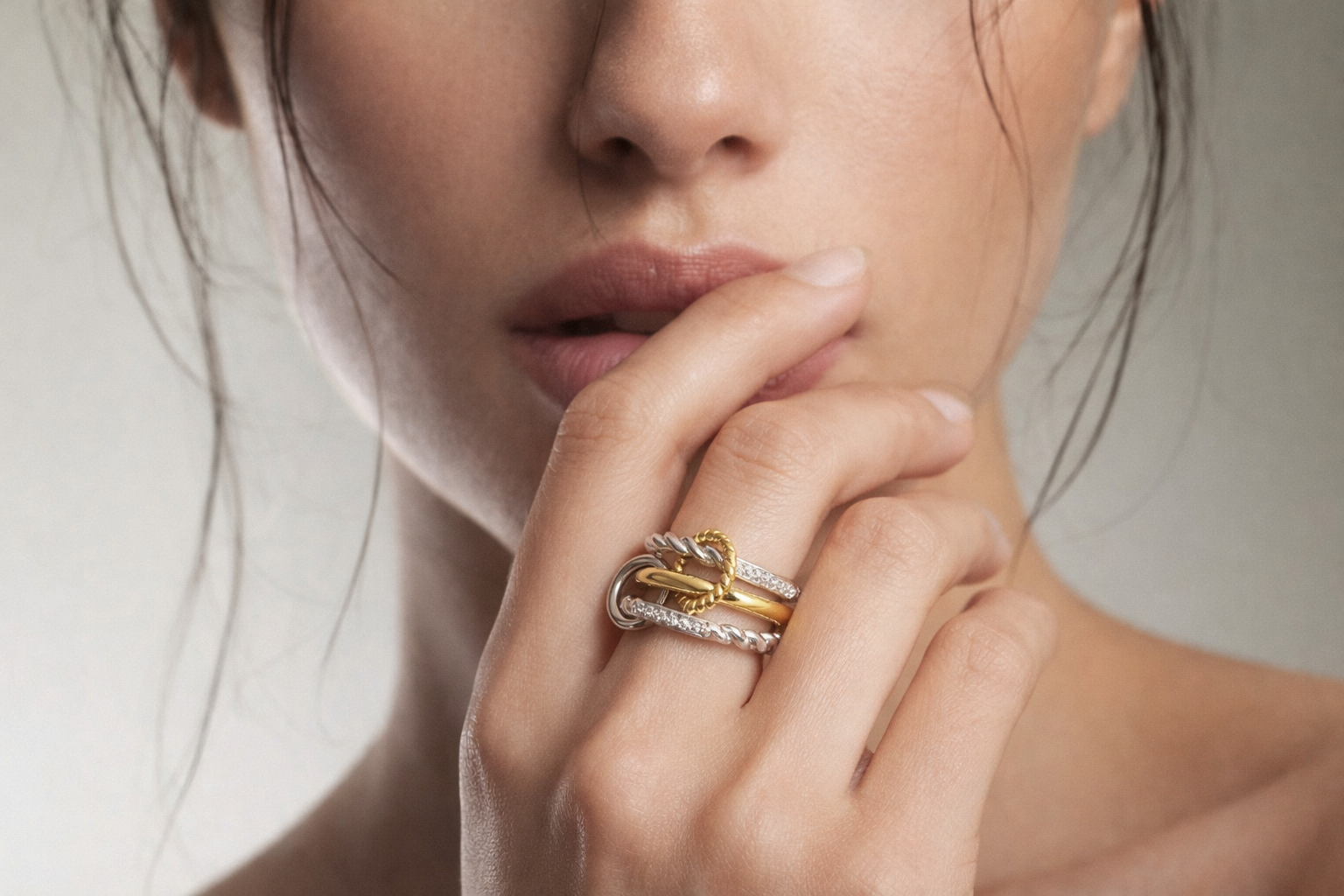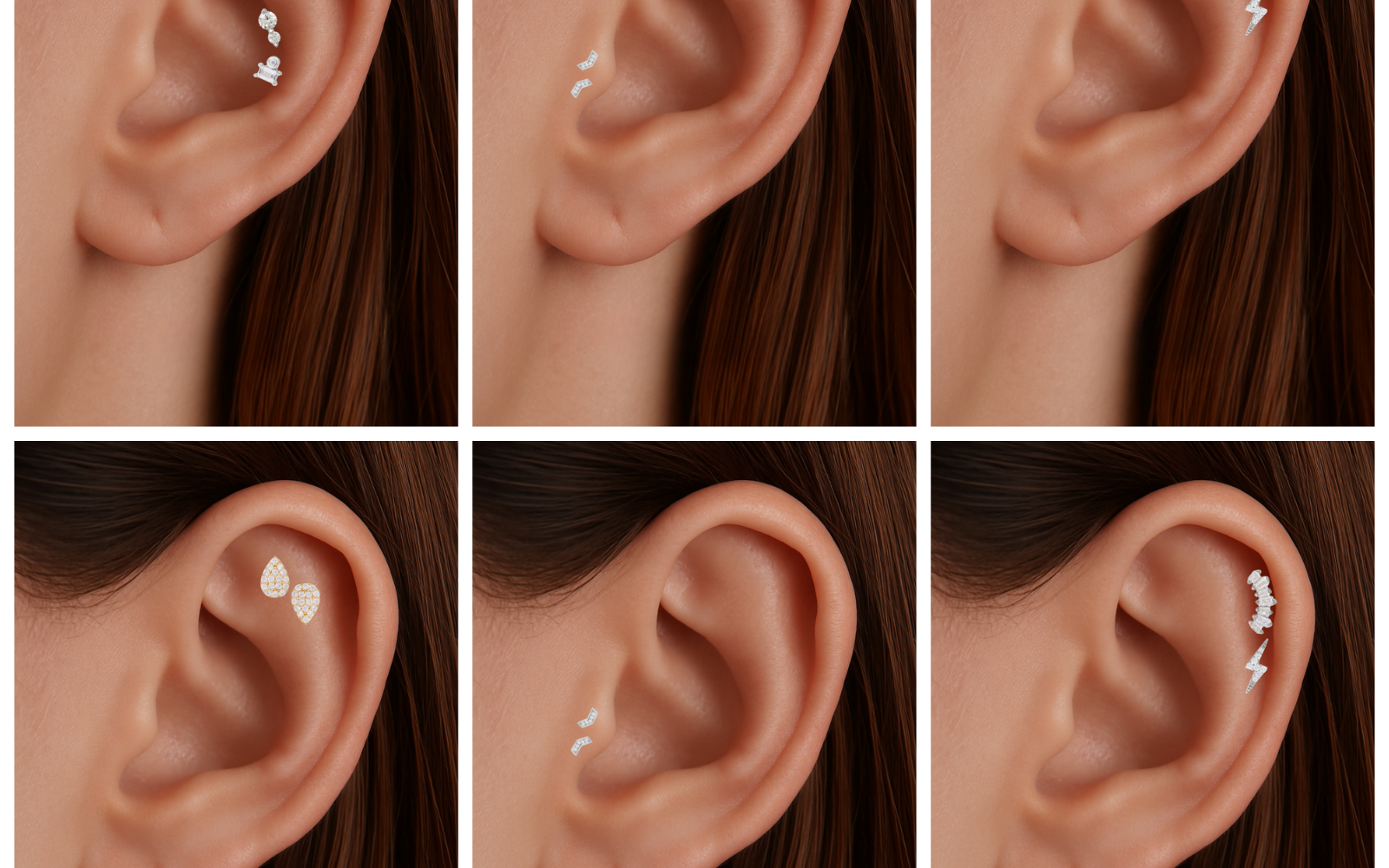
Everything You Need to Know About Ear Piercings
Types, Pain, Aftercare, Healing & Best Jewelry
Shop Ear StoriesEar piercings are a timeless form of self-expression, but getting it right matters. From choosing the perfect placement to ensuring proper aftercare, this guide covers everything you need to know.
Whether you're a piercing newbie or a seasoned pro, we’ve got you covered. Plus, explore our collection of hypoallergenic jewelry to make your piercing journey stylish and safe!
If you're building a layered lobe look or planning your second ear piercing, don’t overlook the power of contrast. The Huda Two Tone Pavé Cross Bar Huggie is a striking piece that blends silver and gold tones, making it ideal for mixing metals across your stack.
🧠 What Piercing Should I Get?
Take our quick quiz to find your perfect piercing match based on your style, pain tolerance, and healing patience.
Ear Piercing Types & Placement
Ear piercings come in a variety of styles, each with its own unique look and placement. Here’s a breakdown of the most popular types:

- Lobe Piercing: The lobe piercing is the most common type, located on the soft lower part of the ear. Healing time is relatively short, typically 4-6 weeks.
- Helix Piercing: Located on the upper outer edge of the ear's cartilage, helix piercings are popular and versatile.
- Daith Piercing: Located in the innermost fold of cartilage, above the ear canal, daith piercings are sometimes believed to help with migraines.
- Forward Helix Piercing: Found on the front side of the ear's cartilage fold, near the inner ear, forward helix piercings are stylish and customizable.
- Conch Piercing: A conch piercing is situated in the center of the ear's cartilage. It can be either an outer or inner conch piercing.
- Tragus Piercing: The tragus piercing is found on the small, protruding piece of cartilage that partially covers the ear canal.
- Conch Piercing: A conch piercing is situated in the center of the ear's cartilage. It can be either an outer or inner conch piercing.


- Nostril Piercing: This is the most popular type of nose piercing, typically placed on the curve of the nostril. It can be adorned with various jewelry types, including studs, hoops, and rings.
- Septum Piercing: A septum piercing is placed through the thin strip of flesh in the middle of the nose, between the nostrils. It is increasingly popular due to its versatility and the range of jewelry options available.
- Rook Piercing: This piercing is placed on the anti-helix ridge above the tragus, offering a distinctive appearance.
📌 Tap the Ear to Discover Your Piercing
Hover over each piercing point to learn more.

Piercing Chart: Least to most painful

Piercing healing time chart
Healing Time and Aftercare
General Healing Times
Healing time for ear piercings can vary significantly depending on the type and location of the piercing:
*Lobe Piercings: Typically heal within 4-6 weeks.
*Cartilage Piercings: These can take anywhere from 6 months to 1 year to fully heal.

Ear Piercing Names
TAKE THE QUIZ: NAME THAT PIERCING
Piercing Master!
You scored 0/6
Does Ear Piercing Hurt? Pain Levels Explained
Let’s address the elephant in the room: Does ear piercing hurt? The answer depends on the type of piercing and your pain tolerance. Here’s a quick pain scale (1 = least painful, 10 = most painful):
- Lobe Piercing: 2/10
- Helix Piercing: 4/10
- Tragus Piercing: 5/10
- Daith Piercing: 6/10
- Conch Piercing: 7/10
- Rook Piercing: 7/10
Ear Piercing Aftercare: Step-by-Step
Proper aftercare is crucial to prevent infections and ensure smooth healing. Follow these steps:
- Clean Twice Daily: Use a saline solution to gently clean the piercing.
- Skip Swimming: Pools and oceans can introduce harmful bacteria.
- Don’t Remove Jewelry: Changing jewelry too soon can delay healing.




Choosing the Best Ear Piercing Jewelry
The right jewelry can make or break your piercing experience. Here’s what to look for:
- Material: Opt for hypoallergenic options like titanium, surgical steel, or 14k gold or sterling silver.
- Style: Start with simple studs for new piercings. Upgrade to hoops or decorative pieces once healed.
Explore Our Collection: Check out our top 10 hypoallergenic studs for new piercings.
@galleriaarmadoro A NEW PIERCING IS ALWAYS A GOOD IDEA Follow Angelina as she gets a new flat rook piercing and freshens up her helix & tragus piercings. She used our ball screw studs - perfect for any cartilage piercing- bought from our retailer @zinafragi_designerjewellery and executed by Aldo at @unicorn.tattoo Our Ball screw studs are made from 925 sterling silver, 100% hypoallergenic perfect for initial piercings. Have piercings questions? Ask us anything below in comments.
♬ original sound - Galleria Armadoro 💎


Infection Prevention & Treatment
Infections can happen, but they’re preventable. Here’s what to watch for:
- Symptoms: Redness, swelling, pus, or excessive pain.
- Treatment: Clean with saline solution and avoid touching. If symptoms persist, consult a doctor.
Prevent Infections: Use our sterile saline solution for daily cleaning.
Ear Piercing for Kids: Safety Tips
Thinking about piercing your child’s ears? Here’s how to do it safely:
- Age: Wait until your child is at least 6 months old.
- Studio: Choose a professional piercer or pediatrician.
- Aftercare: Teach your child to avoid touching the piercing.
Shop Kids’ Jewelry: Browse our adorable starter kits for kids.
Final Thoughts
Ear piercings are a beautiful way to express yourself, but they require proper care and attention. From choosing the right placement to following aftercare tips, this guide has everything you need to start your piercing journey.
Ready to Shop? Explore our collection of hypoallergenic jewelry and aftercare products to make your piercing experience seamless and stylish.





































